The Unplanned, Satisfying Growth of Our Food Forest
Garden Layout Contest
When I first started writing this post, I intended for the post to be my entry for the garden design contest held by @offgrid-online. However, the more I write, the more it is turning into a post about our progress. In this post, I will show you the start of my food forest and how it progressed over the years. I will also show you the layout of my food forest and the plants that I considered must haves.
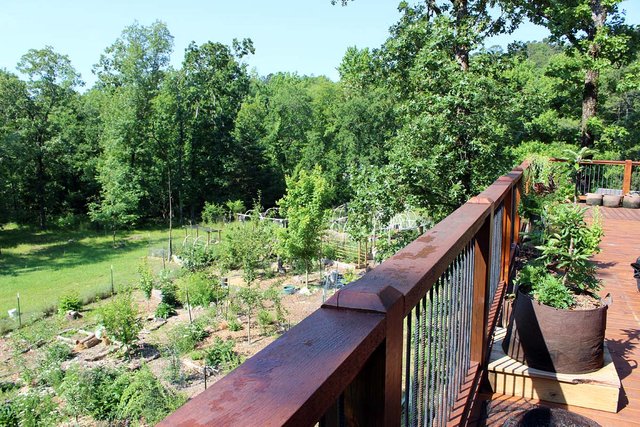
View of the food forest from our deck
The Beginning
I have to admit, I am the type of person that over thinks things and don't tend to start doing anything until I think I am prepared and have learned all that I need to. I am glad I did not let my personality get in the way of starting our first garden. I really did not have a garden layout or design in mind when I first started gardening. I asked my husband for two raised beds and he put them in an area on our property that received the most sunlight.
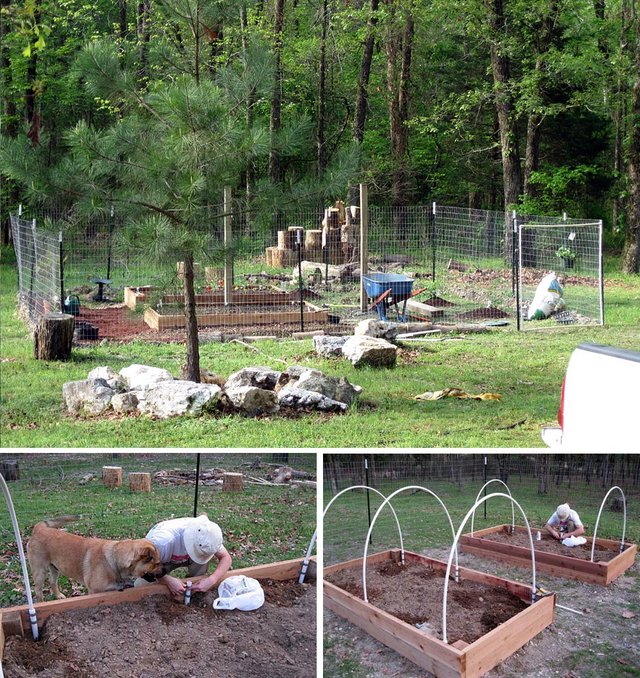
These photos above show the very beginning of our food forest. Photos taken in March of 2012. We started our first year of gardening with two raised beds. Our dog is monitoring the process, making sure it was done properly.
I chose raised beds because the soil on our property is terrible and since I had no experience with growing food when I first started, I thought it would be necessary to bring in better dirt in order to produce. My husband dug down and piled a bunch of rotted wood from our property at the base of each raised bed (inspired by hugelkultur). Then we filled each raised beds with better soil and organic soil amendments.
Fast forward to the second year, we added two more longer raised beds. Then filled the new raised beds the same way we did with the first two raised beds. We continued to add raised beds for the first three years of gardening. Some beds are created with cedar wood and some are created with split logs from trees cut from our property.
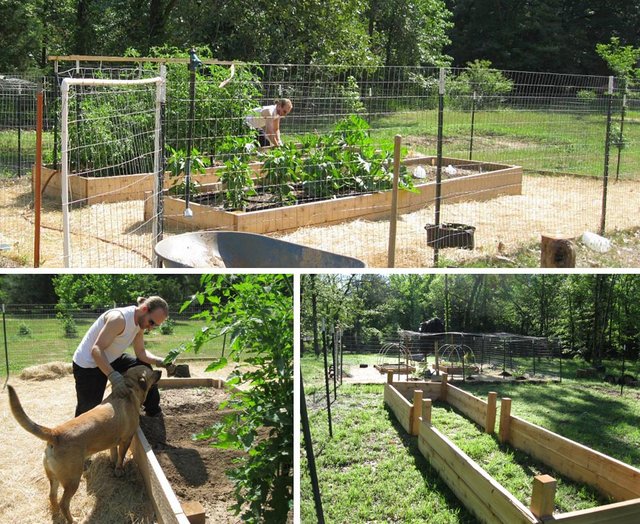
We added two more longer raised beds in the second year (2013). Of course Mr. Dog is always monitoring
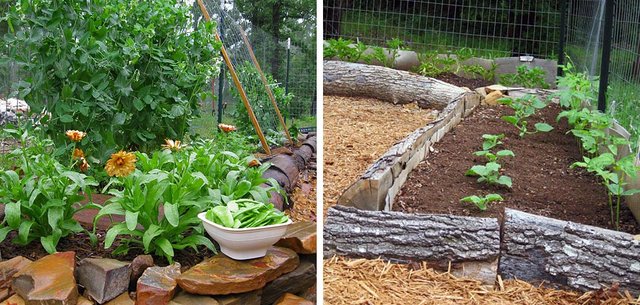
We used logs & rocks from our property to create new beds to save money
We needed to fence the garden from the start, as we have a lot of deer visiting our property daily. And the deer around us seem to eat anything that grows. It is still the case today, so the fencing expands as the garden grows into a food forest.
We decided to add a small orchard three years into our agricultural journey. We expanded our garden to the East side and planted a few fruit trees there. This is when I first started to learn about permaculture. So, I added plants such as comfrey, oregano, yarrow, onion at the base of fruit trees to deter pests and add fertility to the soil. The original orchard area is going into the forth year now and really taking shape. We love the way the orchard area is growing, so we expanded to the West side of the garden and added another orchard this year. Soil building is still the main goal in this newly expanded part of the food forest. We also planted some blueberries and nitrogen fixers in this area during early Spring.
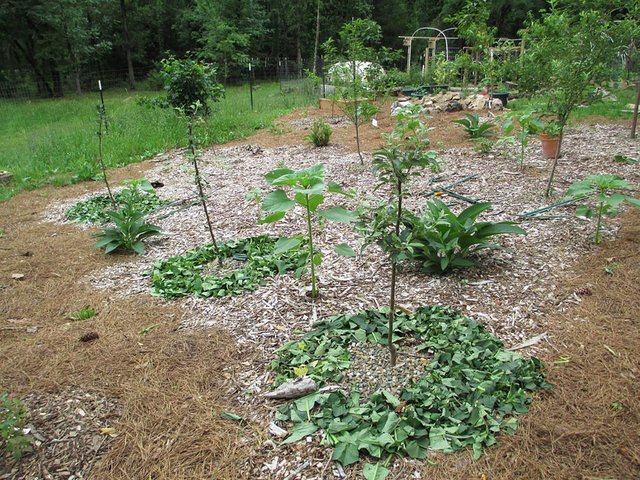
This photo above shows the original orchard we put in in the Fall of 2015. Photo taken May of 2016.
Permaculture was starting to fill my mind around this time. I wanted to implement some of the permaculture principles I had been learning about in books and online. So, an herb spiral was constructed in the Summer of 2016. It was a great way to observe how permaculture principles work in my own food forest. The results encouraged me to continue learning about permaculture and I continued to implement it's principles in the orchard areas.
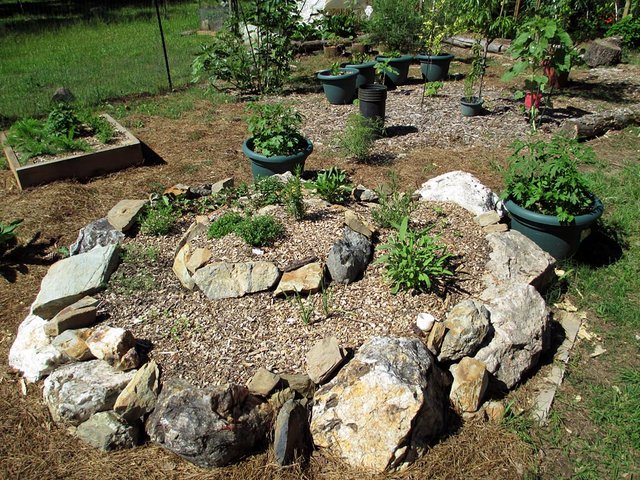
Photo above shows the herb spiral right after it was constructed and planted in June of 2016.
As we bring more and more varieties into the food forest, we needed more trellis. We looked into many different ideas and decided on a tunnel created with cattle panels and T posts. We planted four female and one male Issai hardy kiwi, but after two years of growing them this way, I realized cattle panels are not a good option as a trellis for growing hardy kiwi. The vines tend to wrap around the panel tightly no matter how much I tried to train it to not to. Cattle panel cuts into the wrapped kiwi vines as they get older and thicker. I have been pretty frustrated with the kiwi situation, so this year I did something drastic, I cut the hardy kiwi to about knee high. I didn't care if they died, but I really didn't think they would. After the cut, they are actually doing much better, showing vigorous, healthy growth. One plant is producing more kiwi than any previous year (I guess no relocating it quite yet). My male kiwi died last year, so it appears the variety of kiwis I have are self-pollinating.
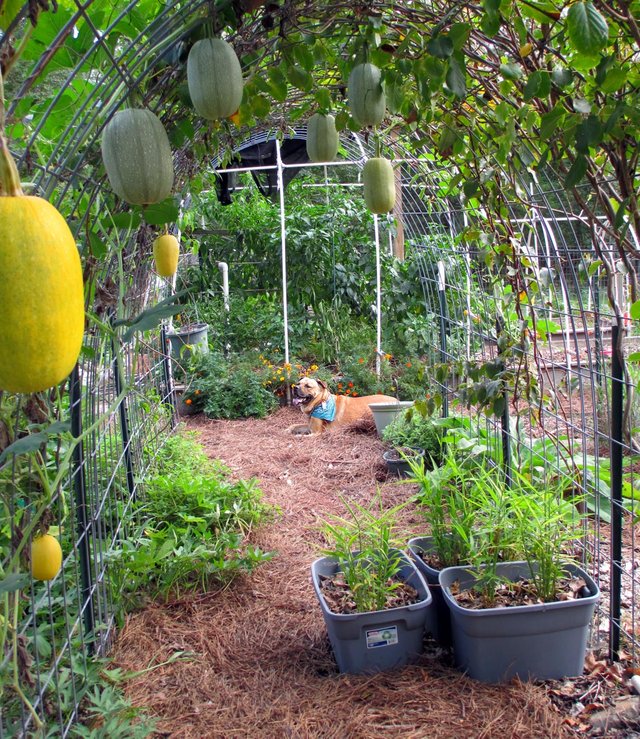
Hardy kiwi and spaghetti squash growing on the cattle panel tunnel. Photo taken September of 2016.
As you can see, I had no specific plans when I first started gardening. I didn't know we would end up creating a food forest and grow as much of our own food as possible. I think this has worked out better for us since we didn't rush into things and made it too overwhelming for us. We took our time learning and observing from our own food forest. We were sharpening our food growing skills while we observe. A few flowering bushes/trees had to be relocated when I realized they were not in the best spot as they grew older and larger.

My Food Forest Layout
Raised Beds (center part of the food forest)
Even though I did not purposely design our food forest the way it is today, it somehow still works and flows perfectly. The center of our food forest has several raised beds to grow annual vegetables, such as tomatoes, peppers, cucumbers, squashes, potatoes, etc. Raised beds allow for easier gardening. Not having to bend over and strain the lower back is well worth the investment of a raised bed. Raised beds also provide much better drainage. Raised beds offer less soil compaction because you are not walking on the beds or near any of the soil that is actually grown in. Raised beds create a longer growing season by warming up earlier than the hard frozen ground. I am able to plant Spring crops earlier with raised beds.
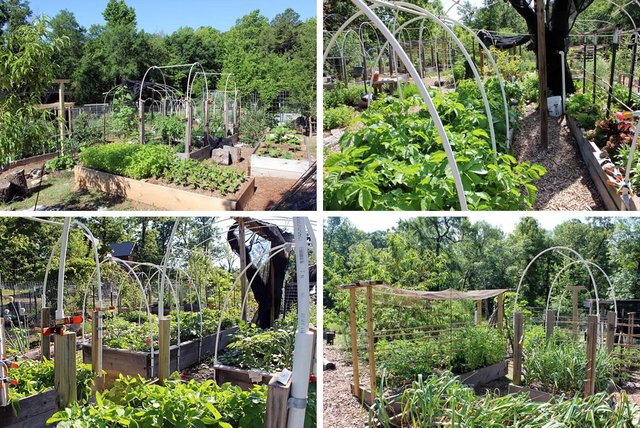
Several raised beds are located in the center of my food forest away from fruit trees. This way I don't have to worry about trees getting too large and shade out the annual vegetables. (Photos taken in 2018)
Orchard Area (East & West part of the food forest)
The way our orchards are planted, we don't have to worry about the fruit trees getting larger and blocking out sunlight for the annual vegetables. I plant intensely in this area following the permaculture principles. The layout in the orchard area mimics nature and when there, makes you feel like you are strolling through a secret, hidden park.
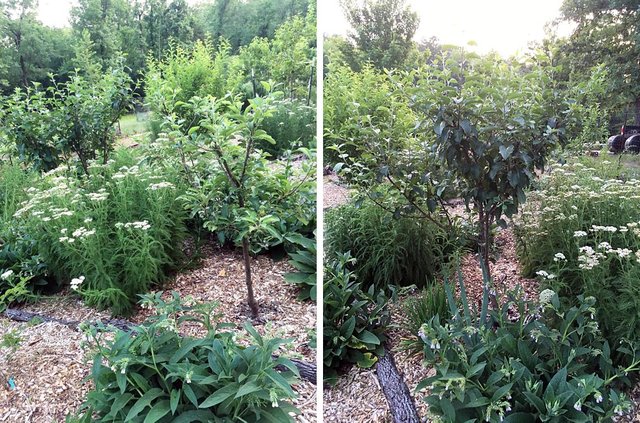
Original orchard area. Fruit trees planted with permaculture tree guild. Plants such as comfrey, yarrow, oregano, rosemary, sea buckthorn, blueberry etc are purposely planted under and around the fruit trees as understory to add fertility, attract beneficial insects, and deter pests. (Photos taken in 2018)
Plants with Purpose
One of the questions in the contest is if you grow specific plants and why. Also, are the plants planted where they are for a specific reason?
I love comfrey and use it to fertilize all the fruits and vegetables I grow. I purposely plant comfrey all around the raised beds and throughout the food forest. I can chop and drop quickly and then use the cut comfrey as mulch throughout the entire growing season. Comfrey has bell shaped flowers that seem addicting to pollinators. Their flowers bloom from Spring to frost, making them a perfect plant to attract pollen transporting insects. Comfrey also needs significant watering, so planted this way, I can water all my annual vegetables and comfrey together. I also make liquid comfrey fertilizer, so additional comfrey is purposely planted throughout the food forest to make sure my comfrey stash never runs out. If interested in making your own liquid comfrey fertilizer, you can read my post on How to make liquid comfrey fertilizer at home

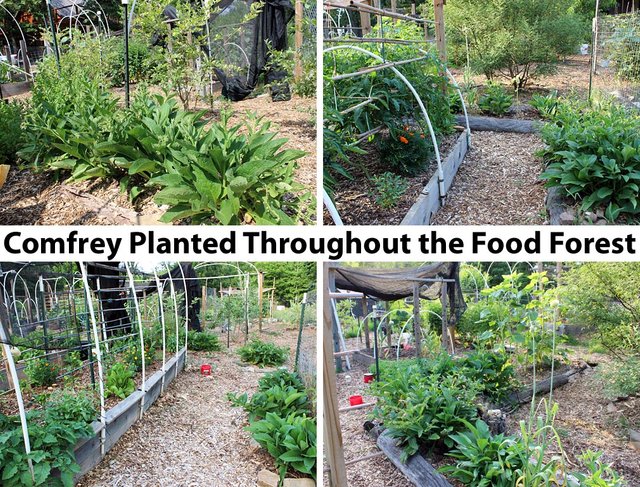
Comfrey is planted throughout the food forest, so I can mulch and fertilize quickly. There are more individual comfrey plants in my food forest than any other plant.

- Marigold & Calendula are must haves in the garden. I plant them at the base of my tomatoes and pepper plants to attract pollinators, deter pests, and just as eye candy.
- Learned from an old farmer that lime basil is amazing at deterring mosquitoes, so I planted some of that this year specifically for that reason. We will see how effective it is.
- I have different herbs such as oregano, rosemary planted everywhere throughout the food forest after learning that the strong scents, or aromas, from these herbs can confuse pests.
- Yarrow is also very useful in the food forest. Its leaves are high in potassium and phosphorus. I plant yarrow at the base of fruit trees to fertilize the trees and attract beneficial insects.
- Sunflowers are always grown in the food forest to attract birds, bees, and beauty. A garden or food forest without sunflowers just looks a little naked. And for the pollinators, they make easy targets, because without pollinators, our food supply would drastically be reduced .

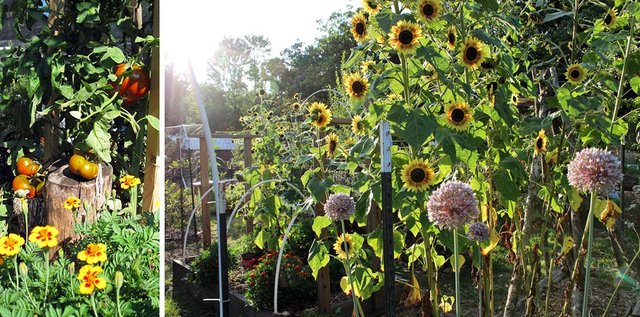
Flowers are not just eye candy, they are necessary to attract pollinators. And without pollinators, our food supply get drastically reduced.

This post has been fun for me to put together. I have not seen photos from the beginning of our journey for years. I now wish I would have taken more and encourage anyone starting a food forest or garden to snap away. Looking back and seeing all the photos really woke me up to how much has been accomplished. And, most of that progress was really done by mother nature, we just planted the seeds. It's quite amazing and encouraging to see how much the garden has grown and with hard work we now have a food forest.

Thank you for taking the time to read my post. If you are interested in submitting an entry to the @offgrid-online garden layout contest, you can read the details of the contest here.

All photos come from my food forest
Photo copyright: @thelaundrylady
I am so glad to find like minded people on Steemit! It's a community I am happy to be part of. If you like my post, please upvote, resteem and comment. I would love to hear from you.
I have nominated your post for inclusion in the new @curateme list.
You are one of the first posts selected!
This is a brand new project that is just getting going; however, is not
yet fully active. I do hope this helps boost your visibility and
rewards as I have found this to be an article I truly enjoyed!
Thank you for so much valuable information. I will have to try more companion planting. I don't have any plants under my fruit trees, what a great idea!
Blessings, @irishgirl
Thank you so much for nominating my post! I truly appreciate any boost for visibility.
I used to keep the area under my fruit trees free of weeds or any other plants thinking they would compete. However, learning the permaculture principles have really opened my eyes up to how nature grows trees.
Thank you for stopping by and commenting!
OMG! @thelaundrylady y'all are killin it! I've been tumbling down the permaculture rabbit hole myself. My perspective has totally changed on weeds. They are now compost/mulch for my blueberries and fig trees in the backyard. Once I found out about wood chips! total game changer :) Love y'alls garden, I know the work that took. Really great knowledge here, I'm working toward a permaculture homestead and this post has some great knowledge for the plant guilds. Thank you for sharing, Amazing job :)
Thank you so much for your kind words! Really appreciate your comment. Same here, I used to not allow anything to grow around fruit trees thinking they would compete, but permaculture method of growing fruit trees changed the way I think. I also use weeds as part of the mulch now mixed in with wood chips.
Mulch has been a total game changer for us too - things I've struggled with in previous years are actually beginning to thrive because we've mulched over the past two summers. We've been mulching with chopped leaves because we have gigantic piles of them in the fall: we pile them into the orchard area and by summer they've settled down to a nice dense mulch blanket. The trees are loving it. And I'm appreciating having to do less watering and weeding.
I think our garden may currently be in a similar state of evolution. I didn't realize the purpose of the flowers was to draw more polinators - my instinct is to keep things clean and neat to try to cut down on pests and weed problems, but it's an interesting thing that my cucumbers have often struggled from under-polination. We have a honeybee hive somewhere in our area because I often see the honeybees; I'm wondering now if adding some bee balm or other bee draws would be a good idea in the orchard area of the garden. I've been trying to stay practical and not get drawn into growing flowers (my first and best gardening success) but I wonder if I might've shot myself in the foot this way!
When I first started gardening, I was thinking the same thing you are "why waste garden space by growing flowers when I am trying to grow food". I quickly realized no flowers means no food. The number one reason people are not successful growing fruit or vegetables is no pollinators. I learned that you must have a varieties of flowers that can bloom at different times, so you have food for pollinators all year long. I now recommend to people who are new to gardening to plant flowers first, then food. If you bring in more diversity, you will be more successful in your garden.
Heh, this is a great reason to get back to growing flowers!
good luck with the contest, you have a beautiful work, i love your squash plants and fruits and kiwis, this squash are diferente than our ayotes or pumpking that we have with my father in El Salvador Central América we have a white color in our local pumpking, and i love too your sunflower flowers, i hope some day have a little plants in our yard.
best regard.
Thank you for your kind words. There are so many different varieties of squash and pumpkins around the world. I bet the white one you have in El Salvador is super tasty. I hope to add more and more different varieties of each vegetable in my food forest . It's my dream anyways.
This is lovely to see how your garden has evolved. Sometimes it is better to go freestyle with it. I love how well it has grown and developed. I like the idea of having comfrey around all the beds. I definitely need to try this.
I loved this post so much, I used the Ecotrain bot to upvote :-) xx<3
Wow, you are so sweet. Thank you so much! We are really trying to help each other out aren't we. I gave you a share of steembasicincome and you gave me a vote from ecotrain bot :) I love being able to help small fish like both of us on this platform. There is so much great content on Steemit, sometimes authors with less followers don't get noticed then get frustrated and drop out. I truly enjoy having you on here lovely lady!
You're so welcome, you helped me out a few weeks ago, so it's good to be able to return the favor! :-) xx
For sure! Steembasicincome (sbi6) will vote for your post forever as long as you continue to post on Steemit. I sponsored you for one share to hopefully encourage you to stay on the platform. See how I am trying to bribe you to stay :) .
Aww that's really cool. I was wondering how it worked xx thank you so much ❤
This pic is insane! The wood chips remind me of the fruit tree orchard I used to live on, the whole backyard was lined with wood chips to hold the moisture in the soil and keep weeds down.
Thank you. I love this pic also! We use lots of mulch in our food forest for that same reason. It builds soil, holds moisture and keeps the weeds down. Thanks for stopping by.
Every time I come to one of your gardening you fill my head so many new and wonderful ideas on how to expand my own garden- THANK YOU for that!
Your raised beds... the hoops... all such a beautiful set up! If I had one more 1/3 of an acre of land to work with I would be gardening ninja!
Thank you for your kind words. I have come across so many great ideas from other people. I am glad you find new ideas for your garden from my post. Thank you for taking the time to read!
Thank you so much for this post. Amazing to see your garden progress, layout, and your strategy behind plant placement. It must be a joy to see how well it has all grown in :)
It really has been a joy to put this post together. Thank you for the great questions and for hosting the contest. I love what you are doing! Found you through EcoTrain.
Wow.. your garden is really inspiring. I really want to experiment with hugelkultur when I have more time. I run a small vegetable farm and I just moved to a new location, so I don't have time to do all the digging and burying. I also greatly appreciate marigolds and am growing a bunch of calendula. I was just reading that marigolds are actually effective at deterring flea beetles which are really messing me up right now. I have about 100 started and ready to transplant that I am going to try and plant around my brassicas and we'll see what happens. Also a huge fan of sunflowers. We planted sunflowers beside our snowpeas in hopes the sunflowers will shade the peas and facilitate summer production and also act as trellising. Also, noticed you are from Oklahoma. I lived there for about 5 years. Moved to Taos, NM now. Thanks for the informative read! Followed!
Thank you @nickhans! I think the reason our raised beds do so well is because of all the rotted wood we buried at the beginning. I love marigolds and have them all around the garden, but I do have to tell you, I still have flea beetles every year. I was told by an old farmer this year to grow "rue" to deter flea beetles. I have not tried it myself, but have read some info online. It looks promising. Just don't plant rue next to cucumbers or cabbage (but my cucumbers are the plants being attacked by flea beetles?!). They don't get along for some reason. Planting sunflowers next to snow peas is a great idea! I would love to know how it works out. I use a lot of shade tarp in the Summer and have been trying to figure out a way to naturally shade some of the crops without having to use a shade tarp. Growing sunflowers would be a great idea to provide shade. Thanks for the inspiration!
@thelaundrylady some amazing pictures you have of your beautiful garden, that arch is a thing of beauty! keep on posting!